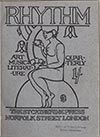Hall Ruffy, “The Death of the Devil”, Rhythm 1 (1911), pp. 24–33.
SPOILER: The Devil dies. Also spirits are mortal. After thousand of years of strenuous work, he dies the very moment he understands that the beauty of the world lies in complexity and diversity.
WHAT: what can we find in the first issue of a magazine, Rhythm, that in 1911 aimed to be “humaner”? how does it help us in our job today? Do we share any of its ambitions to have “purpose” and “see that the present is pregnant for the future, rather than a revolt against the past” (36)?
The story reports a late-night conversation between two gentlemen. Although they are not the kind of people we would like to be – or the kind of people Rhythm contributors wanted to be – there is much to be learnt from their words. In their amicable exchange one finds in facts the main constituents of an early 20th-century vision of the world, which has also shaped the century of two World Wars, a century of genocides, the century of an attempt at reconstruction through the leadership of the economy.
The core of this vision is the embodiment of evil for the sake of the highest good. What is at stake is then a dualist understanding of life dynamics: the world of light fighting against the world of darkness.
The roots of dualist-thinking are then investigated both in their philosophical sources and in the basic iconography of the devil.
As counteractive influence on our time, difference-thinking (or Deleuze’s philosophy of differences) is also referenced here. Dualist thinking is in fact also binarist thinking; reductionist thinking; ageist thinking; racial superiority thinking; exploitist thinking. If one is allowed to make a few words up.
Finally, I tried to answer the questions: Who is the devil? What would happen if the devil was to come back today? What does the death of the devil mean for us today?



